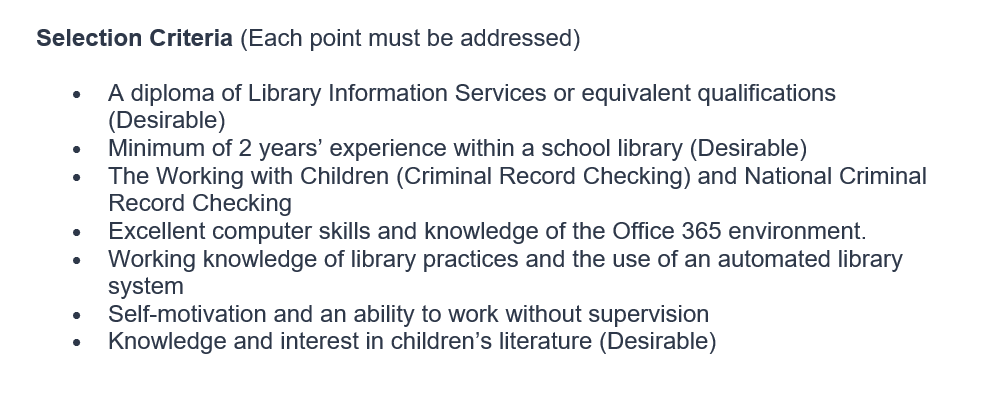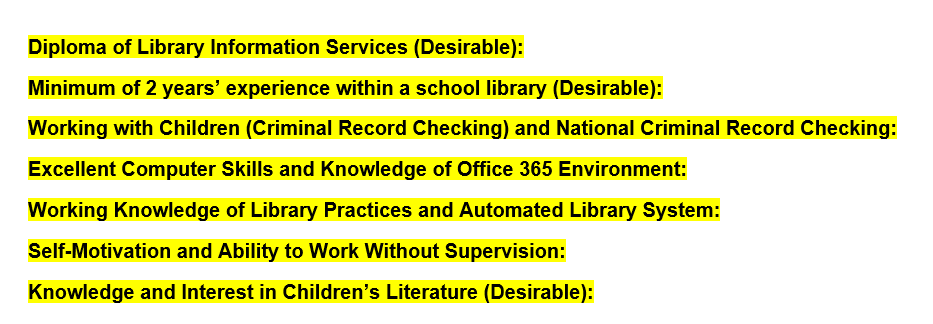Some job applications will ask you to provide a response to selection criteria, as well as your resume or CV. These criteria are the specific skills and experience that a job requires. In many cases, the application guidelines request that the selection criteria should be responded to within a cover letter. (Sometimes, they request a response in a different format, like this APS Statement of Claims example). Many people wonder how to write a cover letter addressing selection criteria, though (as selection criteria writers, we get asked daily!).
While your resume or CV should state that you have the relevant experience, a selection criteria response will require more detail and specific examples. As well as providing more information, selection criteria also provide a structured way to assess candidates.
The job ad might include something like this:

Let’s look at 10 things to keep in mind when addressing selection criteria in a cover letter.
How to Write a Cover Letter Addressing Selection Criteria in 10 Steps
1. Start Your Cover Letter in the Standard Cover Letter Format
Begin your cover letter in the standard format, with a header containing your contact information. Then, include the employer’s contact details, including their name (or a generic salutation like “Dear Hiring Manager”). Use a standard font and font size, like Arial 10-12.

2. (Opening Paragraph): Express Your Enthusiasm
Specifically state the role you are applying for. Convey your eagerness to contribute your skills and experience to the organisation. You might also like to mention the company’s values, and how your own align (tip: be specific and authentic here). If there is something else that attracts you to the organisation (such as a recent company achievement), you might like to mention it here, to show you have a good understanding of them.

3. (Body Paragraphs): List and Highlight Each Selection Criteria
List and highlight each of the selection criteria in the body of the cover letter. This will help you keep on task and ensure each selection criterion is adequately responded to (note: you should remove this at the end – see step 9).

4. (Body Paragraphs): Paraphrase Each Criterion and Your Experience
Write an introductory sentence for each criterion, paraphrasing the language and keywords used in the selection criterion.

5. (Body Paragraphs): Brainstorm Ideas for Each Criterion
Make some notes within your document, then choose your ‘best ideas’. Tip: you’ll need to be as specific as possible. Rather than saying you communicated daily with different customers in a previous role, think of a specific time you communicated with a specific customer, and how you had a positive impact.
6. (Body Paragraphs): Use the STAR Format for Each Example
The STAR format is a well-known way to structure selection criteria. It goes like this:
Situation (S): Briefly set the context by describing the situation or problem you encountered. Keep it concise to provide necessary background information. This section should make up approximately 10% of your response.
Task (T): Describe your specific role or task within the situation. Explain what was expected of you and any challenges or goals you needed to address. This section should make up around 10% of your response.
Action (A): This section should make up around 60% of your response. Describe the actions you took in detail. This is where you showcase your skills, competencies, and problem-solving abilities. Use specific examples, highlight your contributions, and explain your thought process.
Result (R): Approximately 20% of your response. Conclude by outlining the positive outcome or result of your actions. Mention any benefits to the organisation. While this is one of the smaller sections, it is one of the most important. Many candidates forget to include a strong result section.
Note, the STAR method is not necessary for yes/no criteria such as certain qualifications. For these criteria, you can simply state that you have the required qualifications.

7. (Conclusion Paragraph): Sign-off Positively
Conclude your cover letter with a short paragraph thanking the reader for their time, and welcoming the opportunity for an interview. You may like to reiterate your interest in the role.

8. Sign Off as in a Standard Cover Letter
End with a professional sign-off such as ‘Kind regards’ or ‘Yours Sincerely’, along with your full name. There is no need to sign the cover letter.

9. Remove the Highlighted Selection Criteria
Since these headings were included only as a guide for you, you should now remove them. Your introductory sentence within each paragraph will be enough to allow the reader to understand that you have addressed each one.
10. Proof-Read and Submit
Proof-read your document for any errors, including grammar and spelling. You may like to have a friend or family member complete this part for you. Another tip is to save the document as a PDF, and read through it that way (the doucmnet will look slightly different and will allow you to assess it with fresh eyes).
Cover Letter Addressing Selection Criteria Example

Frequently Asked Questions
Can you address selection criteria in a cover letter?
There are a few different formats for responding to selection criteria. Sometimes, you may be asked to respond to specific online questions related to the criteria. Sometimes, you may be asked to provide a ‘separate document’ style selection criteria response. Sometimes, you can address selection criteria in a cover letter. It is important that you thoroughly read the application guidelines to determine what is required.
How long should a cover letter addressing selection criteria be?
A cover letter addressing selection criteria should typically be between one to two pages. If the application guidelines specify a length, you should always adhere to that.
How to address selection criteria you don’t meet?
Selection criteria are sometimes deemed either essential or desirable. You should provide a response to both essential and desirable criteria, even if you don’t meet them. You should provide a summary of your most transferrable skills and experience.
Our selection criteria writers specialise in addressing selection criteria, both in cover letter and other formats.
Contact us if you need more assistance with your application.
Read our latest resume tips.


